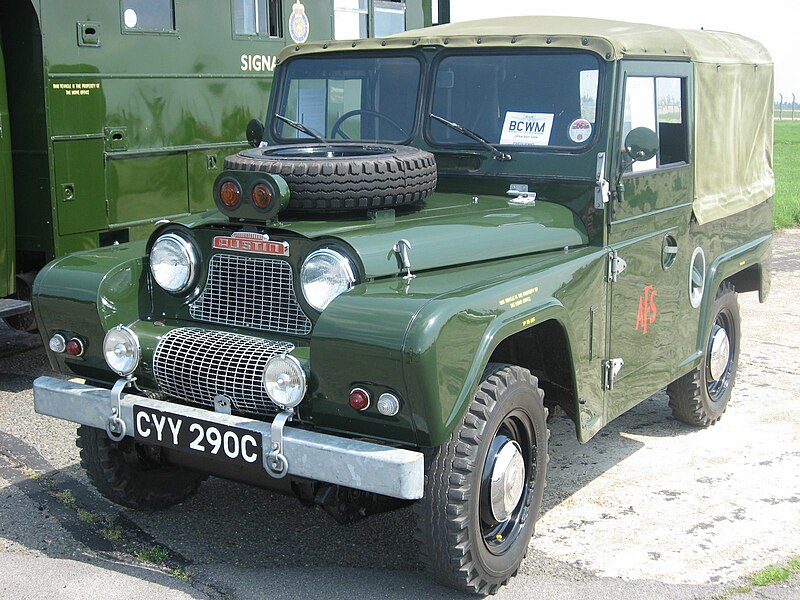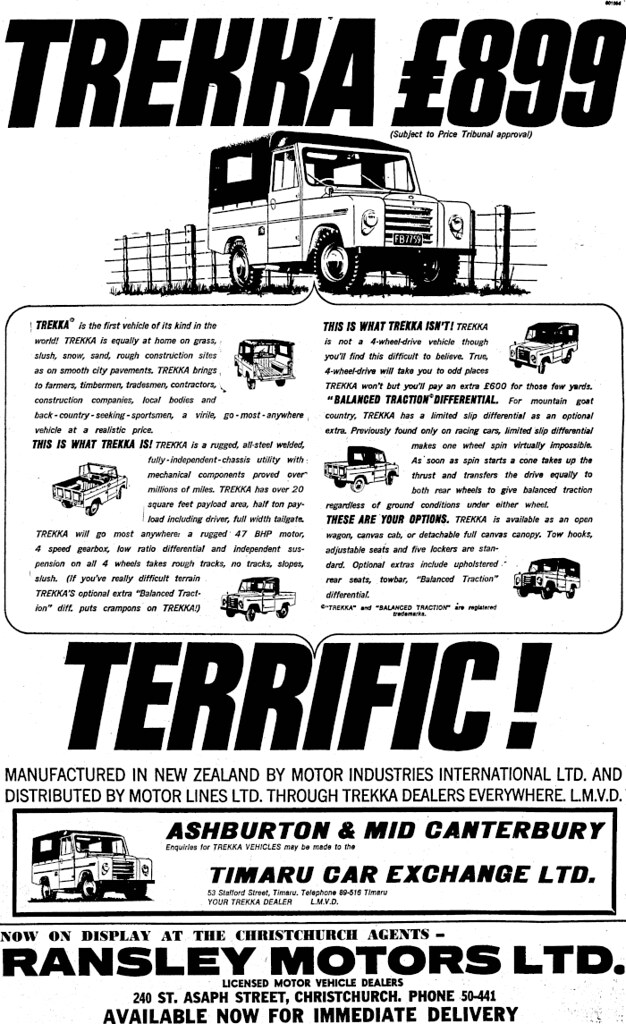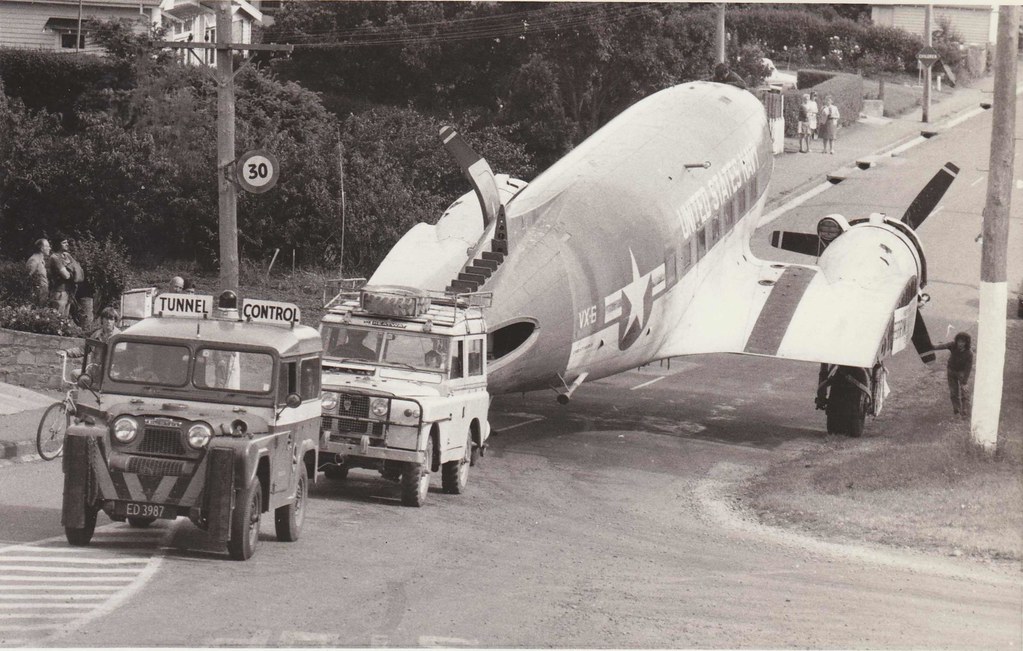|
|
Post by 30sqnatc on May 18, 2022 21:42:43 GMT 12
|
|
|
|
Post by Dave Homewood on May 18, 2022 22:28:45 GMT 12
It's like a Mr Whippy truck and a Mini had a baby.
|
|
|
|
Post by FlyingKiwi on May 19, 2022 18:26:40 GMT 12
Based on a Skoda Octavia, which in a slightly roundabout way our new police cars are too, albeit several generations later...
|
|
|
|
Post by markrogers on May 19, 2022 20:59:20 GMT 12
I've actually been in one when they were around in the early 70's. Sort of looks like a baby Landrover, funny looking little thing
|
|
|
|
Post by Dave Homewood on May 19, 2022 21:28:48 GMT 12
Another rip-off of the Landrover that was being assembled and sold in New Zealand was the Austin Gipsy. I wonder if our military ever ended up using them. en.wikipedia.org/wiki/Austin_Gipsy |
|
|
|
Post by Dave Homewood on May 19, 2022 21:37:06 GMT 12
PRESS, 10 DECEMBER 1966  [/a] |
|
|
|
Post by Dave Homewood on May 19, 2022 21:53:23 GMT 12
TREKKA IS PRACTICAL, ROBUST
FOR years the person wanting a utility-type “workhorse” vehicle for a farm or similar applications has had to choose between the two-wheel-drive pickup versions of cars and commercial vehicles, and the more expensive four-wheel-drive vehicles. But now a newcomer has entered the lists, and filled the gap in the market. It is the Trekka, which combines a strong and practical utility-type body with two-wheel-drive and high ground clearance. The Trekka is of particular interest, for it is New Zealand-designed for New Zealand conditions, and is claimed to include about 80 per cent New Zealand-made components. A brief test of the Trekka this week showed it will go places where it is highly unlikely any other two-wheel-drive vehicle will go. While it will not do all that can be expected of such vehicles as the Land Rover, the Austin Gypsy or the Jeep—-nor is such performance claimed for it—it is vastly cheaper than these vehicles at £899 in basic form, or £940. with a New Zealand-made limited-slip differential. At such a price, and with the many virtues it possesses, it seems certain the Trekka will carve a substantial place for itself in the New Zealand market.
Such a vehicle as the Trekka had been a project in the mind of Mr N. Turner, managing director of the Motor Holdings Group, for years, and about two years ago a simple prototype vehicle was produced. After about a year of experiments and testing, it was decided to go ahead with the project. The company was New Zealand agent for the Czechoslovakian Skoda company, and the robust Skoda engine was chosen to power the new vehicle. The Skoda chassis, modified, was also selected, complete with independent suspension for all wheels. Arrangements were made to have all the body stampings pressed by local firms, and contracts were let for the local manufacture of numerous components.
The Trekka’s specification includes a four-cylinder Skoda engine of 1221 c.c., producing 47 b.h.p. at 4500 r.p.m., and generous torque. Maximum speed is about 70 m.p.h. and fuel consumption ranges from 24 to 34 miles a gallon. The vehicle is slightly more than 12ft long, five feet three inches wide, and six feet three inches high. At present it comes in two forms: with a full canvas hood, or with a canvas-covered cab and open rear deck. A metal canopy will probably be available soon.
In general appearance the Trekka is very similar to the four-wheel-drive utility vehicles, and its all-steel body is well-finished and strong. Simplicity and practicality is the keynote, and the test vehicle had the limited-slip differential, but no other options. Such items as heater, screen washers, radio, extra instruments and so on can be added if the purchaser so wishes. The instruments comprise a speedometer, fuel and water temperature gauges, and warning lights for oil, ignition, headlights, and indicators. The instruments and steering wheel are of Skoda origin, as is the four-speed gearbox, which is controlled by a floor-mounted lever positioned just in front of the pull-up hand- brake between the seats. There is seating for two persons in the front compartment, and benches along the sides of the rear compartment double as tool-boxes, and can be fitted with cushions to provide extra seating.There are oddment compartments in the doors and in the dash.
Visibility through the large windscreen is good, and rear vision through the plastic rear window in the canopy is fair. The wing-mirror fitted as standard fills in the blind spots. Unlabelled knobs on the plain metal dash control wipers, choke, and lights—the starter knob is on the toe-board, a rather inconvenient position. The seats are comfortable, and the floor is fitted with rubber mats. The driving position is good, although very tall drivers may find themselves a little short of seat adjustment
The controls are generally light, although the gearchange is not quite as positive as it could be, and the steering is rather “dead,” although the vehicle has a good lock. The low-ratio differential gives the Trekka surprising flexibility it will pull happily from 5 m.p.h. in top gear, and will start easily in third. Acceleration is surprisingly brisk, and the vehicle feels as if it would cruise all day at 60 m.p.h. at least. Mechanical noise is low, and most of the noise comes from the mud-lug tyres. There are no draughts. The ride is good, and road-holding also seems good on both shingle and seal, although we did not corner the test vehicle really hard.
But the Trekka has been designed for rough going, and it is there that it shows its true character. It will carry a load of half a ton, but on the test we had only a bag of sand in the back, which helped traction somewhat on very steep going. The test course took us up a steep clay road, deservedly marked “unsuitable for cars,” and at one point through long grass over very rough ground on a steep hillside. The first impression was of the surprisingly good ride the vehicle gave over abominable surfaces, and the freedom from rattles or bottoming.
On the second attempt, with virtually no preliminary “run” at all, the Trekka climbed a very steep and slippery slope, mainly comprising clay and rock with slippery grass growing through it. The vehicle only just made it over the top—no other two-wheel-drive vehicle we know of could have done it—and without the limited slip differential would undoubtedly have failed. This option will be a “must” for those expecting really rough going. The vehicle became stuck only when a front wheel dropped into a washed-out channel about 10 in deep and eight inches wide on a steeply-sloping track. The vehicle rested on the front chassis-member, with the front wheel well off the terra firma. However, a few pieces of wood under the front wheel, and the Trekka pulled itself out. A four-wheel-drive vehicle in the same situation might not have become stuck, but it would certainly have had a difficult time.
Apart from this incident, the Trekka romped up and down rough, steep and slippery slopes with surprising ease. Almost certainly no other two-wheel-drive vehicle could have gone where the Trekka went, and had one attempted to take a pick-up over the same country, underbody damage would have been certain. Basically, then, the Trekka, while making no pretence of having the abilities of a four-wheel-drive vehicle, has amazing capabilities in rough going, and at the same time provides quite acceptable road transport. For many farmers, contractors and off-the-road drivers it will serve a very useful purpose at a reasonable price. It does what it is designed to do, and does it well. We can think of only a few possible improvements: a synchronised first gear would be a great help on very rough going, the starter could be more conveniently placed, and the steering needs more “feel” and return action. A winch, a hand-throttle, and a power take-off would be useful “extras.”
PRESS, 23 DECEMBER 1966
|
|
|
|
Post by aeromuzz on May 20, 2022 13:26:26 GMT 12
I've been in one of those many, many times...
My rugby coach right through most of my schoolboy rugby days had one. Talk about noisy, draughty and slow.....
With the back filled with team members, going over the Wainuiomata Hill, we'd be down to snail's pace.
|
|
|
|
Post by camtech on May 20, 2022 21:21:18 GMT 12
We had a couple at Whenuapai as flight line runabouts. Funny things to drive with a Porsche gearbox that had the gate back to front ie 3rd/4th were where 1st/2nd usually are. Quite a few crunches when a newby started driving one. Once conquered tho, were fun to drive.
|
|
ctayfor
Leading Aircraftman

Posts: 5
|
Post by ctayfor on Apr 4, 2023 3:28:12 GMT 12
In the late '60s when I was at Marlborough College, we had a week at Rotoiti Lodge in Nelson Lakes National Park to study geographic and geologic features of the Southern Alps. The ranger vehicles included at least one Trekka which four of my classmates found parked between other vehicles. They each grabbed a corner, lifted it up and shuffled around quarter of a circle and put it down again. This of course meant eventually all of us getting yelled at by one of our teachers because he knew it would be useless trying to identify the culprits. Cars were moved so that the Trekka could be manouvered out and all the students had a good chuckle. No cellphone cameras in those days, unfortunately.
|
|
|
|
Post by denysjones on Apr 4, 2023 8:57:11 GMT 12
At Ferrymead we have a freshly restored Trekka, it was a passion project for a particular individual but it has a justifiable place in NZ vehicle history. Give me a shout if you need detail for when you make the model. Re the Austin Gipsy, the Christchurch-Lyttelton Tunnel Authority had said beast(s), proved most useful on a certain escapade.  |
|
|
|
Post by gooneybird47 on Apr 5, 2023 10:25:06 GMT 12
Back in the day I was an Air Scout in Wellington. Our Scout Master/Leader had a Trekka which we took on a training weekend to Castlepoint. Most scary and uncomfortable thing to travel that distance in. A friend of mine still has one, poor soul.
|
|
|
|
Post by aeromuzz on Apr 26, 2023 14:43:23 GMT 12
|
|



